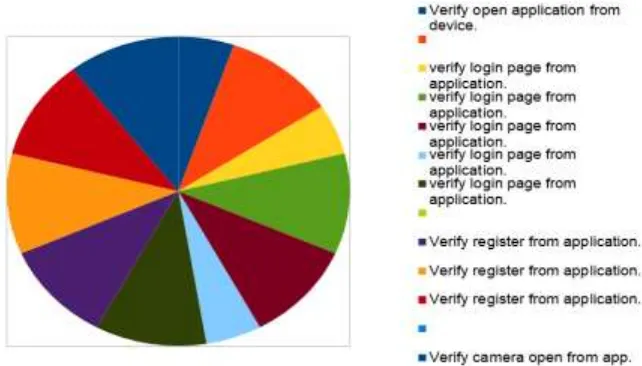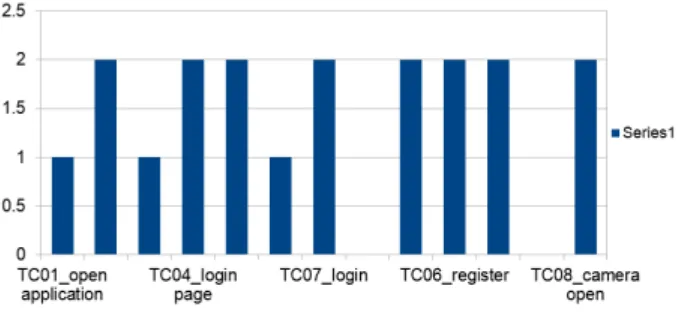Kavale et al. World Journal of Engineering Research and Technology
DRIVER AIDED SYSTEM USING FATIGUE DETECTION
Kajal Karbhal, Madhumati Kavale,* Supriya Kumbhar and Nikhil Lohar
Department of Computer Science, KJ College of Engineering and Management Research,
University of Pune, India.
Article Received on 10/03/2016 Article Revised on 05/04/2016 Article Accepted on 25/04/2016
ABSTRACT
The main motive of this project is to develop android application
which detects driver fatigue and give safety alert to driver. By
analyzing some facial expression it is possible to detect that driver
falling asleep. Increased forehead lines, Eyelids moment, as well as
yawning moment are the facial expression which can be consider as
early signs of drowsiness. Systematic combination of signs of
drowsiness will help to give much more accurate characterization of fatigue state than using
single symptom of fatigue.
Index Terms: Android application, Driver fatigue, Safety alert, Drowsiness.
I. INTRODUCTION
Life saving ideas are more crucial area in today’s research. Now a day’s it is very common
for people for drive themselves to various places like work places. Each person have at least
one vehicle and traffic accident is critical issue. Based on research it is found that 1.3 million
road crashes happens per year and this count increases rapidly day to day. There are many
reasons of road accidents that can be categorized as I] Visual and II[ Non-Visual.
I]Visual
1. Use of Mobile while driving: 300000 of road accidents occur due to texting or calling
while driving.
2. Drowsiness: 71% of road accidents occur due to fatigue of driver.
World Journal of Engineering Research and Technology
WJERT
www.wjert.org
SJIF Impact Factor: 3.419*Corresponding Author
Madhumati Kavale
Department of Computer
Science, KJ. College of
Engineering and
Management Research,
II]Non-Visual
1. High Speed: 1000’s of accidents occurs due to high speed of vehicle.
2. Drink and Drive: 1/3 of road accidents occurs due to drunk driving.
It found that drowsiness is one of major factor for road accidents.
Drowsiness can be defined as tiredness resulting from mental or physical exertion or illness.
Drowsiness occur due to increased working hours, work at night, not getting good sleep, high
blood pressure, heavy weight and other medical issues , It can occurat inappropriate situation
or at inappropriate time. Hence it important to detect drowsiness to avoid accidents.
The rest of this paper is organized as, Section I gives brief introduction, Section II focus on
related work, Section III presents system architecture and working in detail, Section IV
briefly describe algorithm’s used, Section V Presents experimental results, Section VI
summarizes the study.
II. RELATED WORK
Many system are developed to detect driver drowsiness as follows systems detect physical
factors like hand pressure on staring an blood pressure. Heart rate is measured by ECG. As
driver suffer from fatigue, the pressure of hand on staring becomes less and temperature
inside and outside the vehicle also calculated to detect drowsiness.[1]
Eye and eyebrow moments also used to detect fatigue using MATLAB platform. Captured
image converted into binary form, only eye portion of image is stored and other part of image
is discarded. Then eye and eyelid moments calculated and fatigue is detected.[2]
Facial expression and head movement detected using two cameras, this mainly focuses on
bright pupil effect. It minimizes interference with driver driving.[3]
In this paper [4], to detect driver’s drowsiness gaze tracking is method used to prevent
accidents. This approach focus on the head orientation of the driver in each direction and
analyse eye movements like blinking of eyes, closed eye or open eye to detect the level of
sleepiness of driver. Automotive learning and particle filtering algorithm is used in this
approach. This algorithm helps to track head and face movement accurately by camera.
Single camera is used to capture eye movements. This approach does not take various
important factors into account like if driver is wearing glasses, contact lenses. Therefore there
The paper describes an innovative application for assisting driver while driving.[5] This paper
includes non-intrusive measurement approach for detection of driver fatigue and monitoring
driver’s health. Driver Aided system remotely detects the bio-potential signals without any
physical contact with human skin. This does not cause any problem to the user compared to
conventional ways like using electrodes which need to be in contact with human body. Using
delicate sensors and ECG, EEG health can be monitor or eye blinking can be measured. The
system is able to detect the electrical signals through cloth or hair without any contact with
human. This method is not much cost effective because it requires measuring
Electrocardiography (ECG), Electroencephalography (EEG) for health monitoring and eye
blinking detection of driver. It does not consider other conditions like yawning and tracking
facial expression to provide all type of fatigue detection.
III.SYSTEM ARCHITECTURE AND WORKING
System architecture of proposed system is given in figure below Proposed Method makes use
of android and OpenCV library. OpenCV provides training dataset which makes it easy to
detect face and track facial expressions and various regions on face. Alarm system includes
The whole system consists of three parts
a) Eye Detection
b) Forehead Detection
c) Yawning Detection
Eye Detection
Eyes are present on the top portion of face i.e. eyes are present at the few pixels below from
top of face. After Face detection, we track eyes by using Haar classifier training set.
Rectangular frame are used to show both left and right eye. To detect open eyes we track
pupils using black coloured pixel which represents open eyes and if closed eyes. In this if
white pixels are detected then eyes are in open state and if white pixels are not detected then
eyes are in closed state. Through the decrease in the distance of eyelids, closed eyes are
detected. If these pupils are not detected for given fraction of time then system will ring
alarm.
Forehead Detection
Driver Aided System (DAS) detects stress by detecting driver’s facial expressions. Stress is
measured by tracking facial expressions like forehead lines comes in stress conditions or
raised eyebrows. Algorithm used for mouth tracking is used for driver’s forehead Detection.
After forehead detection system calculates no of lines on the forehead. If eyebrows are in
raised condition for fraction of time or if forehead lines appears for the given fraction of time
or both then stress gets detected by system. System raises an alarm to alert driver and
Yawning Detection
Yawning is a pre-drowsy state. Open mouth helps to track yawning. When mouth is open,
inside area is darker. Same algorithm which is for eye tracking is used for yawn detection.
The only difference is increased distance between lips are calculated in yawn detection. Here
we track black region i.e. darker area to detect open mouth. If the distance of mouth increases
then yawning is detected and after this system alerts driver by providing voice alert. Driver’s
mouth contour is used to detect yawning.
Flow Chart
V. Technologies and Algorithms
OpenCV
Open Source Computer Vision (OpenCV) is an image processing library which provides real
time image processing. OpenCV is freely available to use. It provides fast processing and
requires low power for processing. This library contains more than 2500 algorithms. These
algorithms are used in different applications like Face recognition, facial regions tracking,
segmentation, 2D and 3D object identification, tracking objects in motion, identifying
moving objects action. OpenCV also provide input/output libraries for real time video
acquisition and processing of each frame in video. OpenCV runs on Windows, Android, iOS,
OpenCV is becoming very popular library in image processing environment. OpenCV have
many important features like Speed, Efficiency, Portability etc.
OpenCV provides different Machine Learning algorithms as follows
1. Haar Detector: Haar detector is used for face detection purpose and for various facial
region tracking.
2. K-Means: It is clustering algorithm used for distribution of data by allocating it to specific
categories
3. Naïve Bayes Classifier: It is one of the probabilistic classifier which is often assumed to
be Gaussian distribution.
In this project mainly used algorithms are
a) Haars Cascade Algorithm
b) HSV Algorithm
Algorithm for proposed System is
1. Acquire driver’s picture from front camera of smartphone
2. Then from real time captured image driver’s face is detected using
haarcascade_frontalface_alt.xml
3. Then after detection of face region of interest is marked on face.
4. Centroid of face is calculated which is generally nose.
5. After selection of ROI (Region of Interest), other facial regions are tracked for detection
of fatigue
V. RESULTS
Figure 7: Graphical Analysis
VI. CONCLUSION
Proposed Real time Driver Aided System helps to reduce accidents occurred by driver fatigue
and drowsiness while driving. It provides real time driver’s facial tracking. By tracking
different fatigue and stress conditions; Driver Aided System (DAS) provides all level of
drowsiness detection by tracking sleepiness, yawning and stress status of driver. DAS has
potential of tracking driver fatigue by using all above methods to detect fatigue and keep
driver alert by raising alarm.If the eyes are closed for some fraction of time then system will
raise an alert. Same process is used for assessing yawning conditions. If mouth is open for too
much time then system detects yawning and alerts user. Driver Aided System detects facial
expressions of driver and detects stress from expression then alerts driver and passenger (if
available) if stress is detected. DAS uses OpenCV library to implement all functionalities
because of its fast processing and efficient working for fatigue detection by facial tracking.
VII. REFERENCES
1. E. Rogado, J.L. García, R. Barea, L.M. Bergasa. “Driver Fatigue Detection System.”
2. Amandeep Singh, Jaspreet Kaur. ”Driver Fatigue Detection Using Machine Vision
Approach.”
3. QiangJi, Zhiwei Zhu, and PeilinLan. “Real-Time Nonintrusive Monitoring and Prediction
of Driver Fatigue.”
4. Xianping Fu, Xiao Guan, Eli Peli, Hongbo Liu, and Gang Luon. “Automatic Calibration Method for Driver’s Head Orientation in Natural Driving Environment.”
5. Ye Sun, Student Member, IEEE, Xiong Yu, Member, IEEE “An Innovative Non-intrusive
6. P.Hasani I, 2S.Sruthi, 3P.S.Smitha. “Mobile application to detect drowsiness and alert
driver.”
7. Mr. Swapnil V. Deshmukh #1, Ms.Dipeeka P. Radake*2, Mr.Kapil N. Hande#3. “Driver
fatigue Detection Using Sensor Network.”
8. Ji Hyun Yang, Zhi-Hong Mao, Louis Tijerina, Tom Pilutti, Joseph F. Coughlin, and Eric
Feron. “Detection of Driver Fatigue Caused by Sleep Deprivation.”
9. Hardeep Singh, Mr. J.S Bhatia, Mrs. Jasbir Kaur. “Eye Tracking based Driver Fatigue
Monitoring and Warning System.”
10. S.P.Bhumkar, V.V. Deotare, R.V. Babar “Accident Avoidance and Detection on
Highways.”
11. Betsy Thomas, Ashutosh Gupta “Wireless Sensor Embedded Steering Wheel for Real
Time Monitoring of Driver Fatigue Detection.”
12. Monali Gulhane, P.S. Mohod “Intelligent Fatigue Detection and Automatic Vehicle Control System”
13. Veena.S.L, R. Subhashini. “Driver Alertness Based on Eye Blinking and Bio-Signals.”
14. Wen-Bing Horng, Chih-Yuan Chen, Jian-Wen Peng, Chen-Hsiang Chen “Improvement
of Driver Fatigue Detection System Based on Eye Tracking and Dynamic Template
Matching”
15. Yong Du, PeijunMa, Xiaohong Su, Yingjun Zhang. “Driver Fatigue Detection Based on

